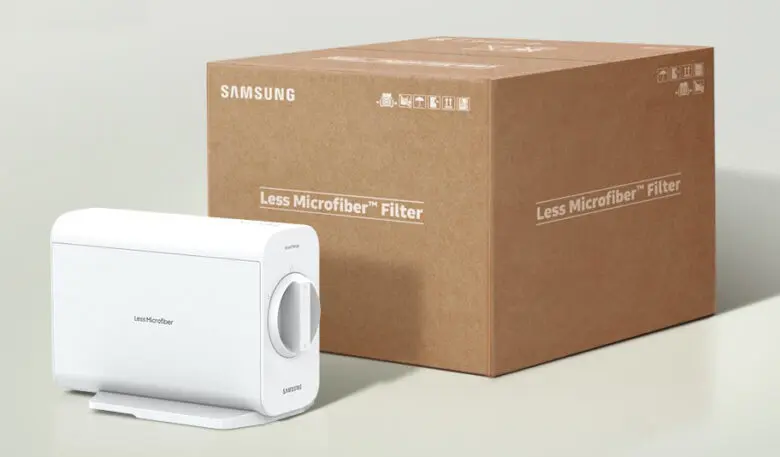Eight years ago, Patagonia started to study a little-known environmental problem: With every load of laundry, thousands (even millions) of microfibers, each less than 5 millimeters long, wash down the drain. Some are filtered out at water treatment plants, but others end up in the ocean, where fibers from synthetic fabric make up a surprisingly large amount of plastic pollution—35%, by one estimate. Fragments of your favorite sweatshirt might now be floating in the Arctic Ocean.
In a collaboration that began two years ago, the company helped inspire Samsung to tackle the problem by rethinking its washing machines. Today, Samsung unveiled its solution: A new filter that can be added to existing washers and used along with a “Less Microfiber” cycle that Samsung also designed. The combination makes it possible to shrink microfiber pollution by as much as 98%.

The project grew out of conversations between the two companies after Patagonia had spent years exploring various options. Initially, it worked with researchers to learn which fabrics shed the most; synthetic fleece, like the kind Patagonia makes from recycled plastic, was one particular culprit. It started selling mesh bags that can capture microfibers in the wash. It tested every laundry filter on the market. It updated garment care instructions to ask customers to wash as little as possible, and spot clean fleece. And when a Patagonia executive gave a Zoom presentation to Samsung in 2021 about how the outdoor retailer approaches social and environmental responsibility, the issue came up again.
“I mentioned to a group of executives that, like any other company, we faced difficult environmental challenges—microfiber pollution prominent among them,” says Vincent Stanley, one of Patagonia’s original employees, who now serves as “director of philosophy,” sharing the company’s values and approach both internally and externally. “I mentioned that we had been unable to get a washing machine manufacturer to work with us, then remembered that they make appliances and blurted out, ‘Say, you make washing machines.’ I regretted my rudeness. But they quickly took up the challenge.”

After the meeting, the two companies kept talking. “They got into a virtual room with us, and we told them everything we knew about testing and how they could test consistently,” says Matt Dwyer, vice president of impact and innovation at Patagonia. Then Patagonia’s team connected Samsung with Ocean Wise, a nonprofit that tests fiber shedding among its mission to protect and restore our oceans. Samsung shipped some of its machines to Ocean Wise’s lab in Vancouver, where researchers started to study how various parameters change the results. Cold water and less agitation helped—but both of those things can also make it harder to get clothing clean.
“There are maybe two ways of increasing the performance of your washing machine,” says Moohyung Lee, executive vice president and head of R&D at Samsung, through an interpreter. “Number one is to use heated water. That will obviously increase your energy consumption, which is a problem. The second way to increase the performance of your washing machine is to basically create stronger friction between your clothes . . . and this friction and abrasion of the fibers is what results in the output of microplastics.”
Samsung had already developed a technology called “EcoBubble” to improve the performance of cold-water cycles to help save energy, and it tweaked the technology to specifically tackle microfiber pollution. “It helps the detergent dissolve more easily in water so that it foams better, which means that you don’t need to heat up your water as much, and you don’t need as much mechanical friction, but you still have a high level of performance,” Lee says.
The new “Less Microfiber” cycle, which anyone with a Samsung washer can download as an update for their machine, can reduce microfiber pollution by as much as 54%. To tackle the remainder, the company designed a filter that can be added to existing washers at the drain pipe, with pores tiny enough to capture fibers.
They had to balance two conflicting needs: They wanted to make it as simple as possible to use, so consumers didn’t have to continually empty the filter, but it was also critical that the filter wouldn’t get clogged, potentially making water back up and the machine stop working. The final design compresses the microfibers, so it only has to be emptied once a month, and sends an alert via an app when it needs to be changed. Eventually, in theory, the fibers that are collected could potentially be recycled into new material rather than put in the trash. (Fittingly, the filter itself is also made from recycled plastic.)
When OceanWise tested the cycle and filter together, they confirmed that it nearly eliminated microfiber pollution. Now, Samsung’s challenge is to get consumers to use it. The filter, which is designed to be easily installed on existing machines, is launching now in Korea and will launch in the U.S. and Europe later this year. The cost will vary by market, but will be around $150 in the U.S. The cycle, which began to roll out last year, can be automatically installed on WiFi-connected machines.
Other companies are also beginning to work on solutions, spurred in part by new regulations. In France, for example, manufacturers will have to include filters on washing machines by 2025. “One of the reasons that I’m so happy to see this progress is that six or seven years ago, we had no fewer than five big appliance makers tell us, ‘That’s the tire companies’ problem,'” says Dwyer. (Tires are another large source of microplastic pollution.) “So to start seeing this activation energy spur movement within these appliance companies is really cool.”
Patagonia is also continuing to look for solutions. One next step could be clothes dryers, which also release microfibers. It’s also studying the possibilities of redesigning materials, though designing a fabric that doesn’t shed fibers has so far proved elusive. The company doesn’t have plans to eliminate synthetic fabric, noting that more research is needed on the impact of natural fibers; some of those studies are beginning now.
Each season, as the brand develops new products, Patagonia studies how much each fabric sheds. “If something comes through our doors and it sheds too much over the threshold, we will go back to the drawing board and redevelop the fabric,” says Dwyer. “It won’t get to the point where it can end up in our product.” As the company and a handful of other apparel brands try to work on the upstream challenge, updating washing machines can fill a huge gap.
“I think it’s massively significant as a step toward mitigating this problem,” says Charlie Cox, who manages the microplastic solutions program at Ocean Wise and worked on the project with Samsung. “And it’s showing that the science and technology is available for us to make these interventions now.”
Recognize your brand’s excellence by applying to this year’s Brands That Matter Awards before the early-rate deadline, May 3.
